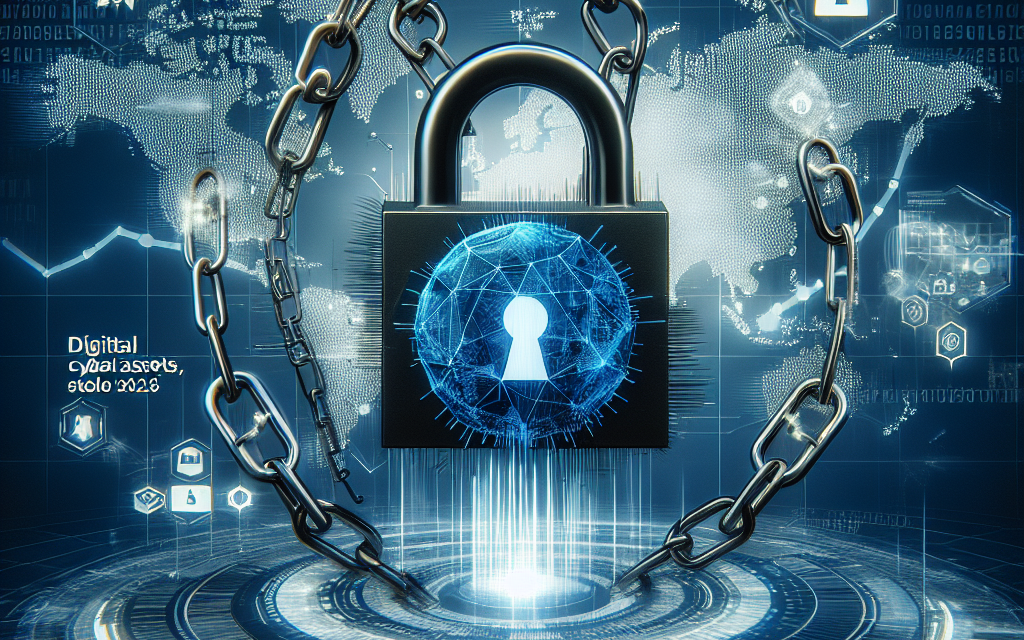“Fortify Your Future: Secure Your Crypto Assets in a Post-Hack World.”
Introduction
In 2024, the cryptocurrency landscape faced unprecedented challenges as hackers exploited vulnerabilities, resulting in a staggering $1.49 billion in losses. As digital assets continue to gain popularity, the need for robust security measures has never been more critical. This guide, “Protecting Your Crypto: How to Secure Your Assets,” aims to equip investors and enthusiasts with essential strategies to safeguard their cryptocurrencies against theft and fraud. By understanding the risks and implementing best practices, individuals can protect their investments and navigate the evolving world of digital finance with confidence.
Best Practices for Securing Your Crypto Wallet
In the rapidly evolving landscape of cryptocurrency, the importance of securing your digital assets cannot be overstated, especially in light of the staggering $1.49 billion lost to hacks in 2024 alone. As the frequency and sophistication of cyberattacks continue to rise, adopting best practices for securing your crypto wallet is essential for safeguarding your investments. One of the most fundamental steps in this process is choosing the right type of wallet. Hardware wallets, which store your private keys offline, are widely regarded as one of the most secure options available. By keeping your keys disconnected from the internet, you significantly reduce the risk of unauthorized access. Conversely, software wallets, while more convenient for daily transactions, are inherently more vulnerable to online threats. Therefore, if you are serious about protecting your assets, consider investing in a reputable hardware wallet.
Once you have selected a suitable wallet, the next step is to implement strong security measures. This begins with creating a robust password that combines letters, numbers, and special characters. Avoid using easily guessable information, such as birthdays or common words, as these can be exploited by hackers. Additionally, enabling two-factor authentication (2FA) adds an extra layer of protection. By requiring a second form of verification, such as a code sent to your mobile device, you can significantly enhance the security of your wallet. It is also advisable to regularly update your passwords and 2FA settings to mitigate the risk of potential breaches.
Furthermore, it is crucial to remain vigilant against phishing attacks, which have become increasingly prevalent in the crypto space. Cybercriminals often employ deceptive tactics to trick users into revealing their private keys or login credentials. To combat this threat, always verify the authenticity of websites and communications before entering sensitive information. Be cautious of unsolicited emails or messages that request personal details, and consider using a password manager to help you keep track of your login information securely.
In addition to these preventive measures, regularly backing up your wallet is essential. This practice ensures that you can recover your assets in the event of a device failure or loss. Most wallets provide options for creating backups, which should be stored in a secure location, such as an encrypted USB drive or a safe deposit box. By maintaining multiple copies of your backup, you can further safeguard against potential disasters.
Moreover, staying informed about the latest security developments in the cryptocurrency space is vital. The landscape is constantly changing, with new threats emerging regularly. By following reputable news sources and engaging with the crypto community, you can stay abreast of potential vulnerabilities and best practices for securing your assets. Additionally, consider participating in forums or groups that focus on cryptocurrency security, as these platforms often share valuable insights and tips.
Lastly, it is essential to be cautious about the information you share online. Oversharing personal details on social media or forums can inadvertently expose you to risks. Cybercriminals often exploit publicly available information to target individuals, so maintaining a low profile can be an effective strategy for protecting your assets. By implementing these best practices, you can significantly enhance the security of your crypto wallet and mitigate the risks associated with the ever-evolving threat landscape. Ultimately, taking proactive steps to secure your digital assets is not just a matter of precaution; it is a necessary strategy for ensuring the longevity and safety of your investments in the world of cryptocurrency.
Understanding Two-Factor Authentication for Crypto Safety
In the rapidly evolving landscape of cryptocurrency, the importance of securing digital assets cannot be overstated, especially in light of the staggering $1.49 billion lost to hacks in 2024 alone. As cyber threats continue to proliferate, understanding the mechanisms of protection becomes paramount for investors and users alike. One of the most effective methods to enhance security is through the implementation of two-factor authentication (2FA). This additional layer of security serves as a critical safeguard against unauthorized access, making it significantly more challenging for malicious actors to compromise accounts.
To begin with, it is essential to grasp the fundamental concept of two-factor authentication. Unlike traditional password-only systems, which rely solely on something the user knows, 2FA requires two distinct forms of verification before granting access. Typically, this involves a combination of something the user knows, such as a password, and something the user possesses, like a mobile device or hardware token. By necessitating both elements, 2FA effectively mitigates the risk of unauthorized access, even if a password is compromised.
Moreover, the implementation of 2FA can take various forms, each offering different levels of security. The most common method involves the use of a mobile application, such as Google Authenticator or Authy, which generates time-sensitive codes that users must enter alongside their passwords. This method is particularly effective because the codes are ephemeral, meaning they expire after a short period, thus reducing the window of opportunity for attackers. Additionally, some platforms offer SMS-based verification, where a code is sent to the user’s registered phone number. While this method is convenient, it is worth noting that it may be less secure than app-based authentication due to vulnerabilities associated with SMS interception.
Transitioning from the types of 2FA, it is crucial to recognize the importance of enabling this feature across all cryptocurrency exchanges and wallets. Many platforms now offer 2FA as a standard security measure, yet a significant number of users neglect to activate it. This oversight can lead to devastating consequences, particularly in an environment where cybercriminals are constantly seeking new targets. By taking the proactive step of enabling 2FA, users can significantly bolster their defenses against potential breaches.
In addition to enabling 2FA, users should also consider the importance of maintaining good security hygiene. This includes regularly updating passwords, using unique passwords for different accounts, and being vigilant about phishing attempts. Cybercriminals often employ sophisticated tactics to trick users into revealing their credentials, making it imperative for individuals to remain cautious and informed. Furthermore, utilizing password managers can streamline the process of creating and storing complex passwords, thereby enhancing overall security.
As the cryptocurrency market continues to mature, the need for robust security measures will only intensify. Two-factor authentication stands out as a fundamental tool in the arsenal of crypto safety. By understanding its mechanisms and actively implementing it, users can significantly reduce their vulnerability to hacks and unauthorized access. Ultimately, the responsibility for securing digital assets lies with the individual, and embracing practices such as 2FA is a critical step toward safeguarding one’s financial future in an increasingly perilous digital landscape. In conclusion, as the threat landscape evolves, so too must our strategies for protection, making two-factor authentication an indispensable component of any comprehensive security approach in the world of cryptocurrency.
The Importance of Hardware Wallets in Protecting Your Assets
In the rapidly evolving landscape of cryptocurrency, the importance of securing digital assets cannot be overstated, especially in light of the staggering $1.49 billion lost to hacks in 2024 alone. As cyber threats continue to proliferate, individuals and institutions alike must adopt robust security measures to safeguard their investments. One of the most effective strategies for protecting cryptocurrency is the use of hardware wallets, which offer a level of security that software wallets and exchanges cannot match.
Hardware wallets are physical devices designed specifically for storing cryptocurrencies offline. This offline storage significantly reduces the risk of hacking, as these wallets are not connected to the internet, making them less vulnerable to cyberattacks. Unlike software wallets, which can be susceptible to malware and phishing attempts, hardware wallets provide a secure environment for private keys—the critical components that grant access to one’s cryptocurrency holdings. By keeping these keys offline, users can effectively shield their assets from unauthorized access.
Moreover, hardware wallets often come equipped with advanced security features that enhance their protective capabilities. For instance, many devices require users to enter a PIN or passphrase before granting access, adding an additional layer of security. Additionally, some hardware wallets incorporate biometric authentication, such as fingerprint recognition, further ensuring that only the rightful owner can access the stored assets. This multifactor authentication process is crucial in an era where cybercriminals are increasingly sophisticated in their methods.
Transitioning from the technical aspects, it is essential to consider the user experience associated with hardware wallets. While some may perceive these devices as complex or cumbersome, many manufacturers have prioritized user-friendly designs and interfaces. This focus on usability allows even those who are not technologically savvy to navigate the wallet’s features with relative ease. Furthermore, the process of transferring funds to and from a hardware wallet is straightforward, making it an accessible option for both novice and experienced cryptocurrency users.
In addition to their inherent security advantages, hardware wallets also provide peace of mind. Knowing that one’s assets are stored in a secure, offline environment can alleviate the anxiety that often accompanies cryptocurrency ownership. This sense of security is particularly important in light of the recent surge in hacking incidents, which have left many investors feeling vulnerable. By investing in a hardware wallet, individuals can take proactive steps to protect their financial future and mitigate the risks associated with digital asset ownership.
Furthermore, it is crucial to emphasize the importance of purchasing hardware wallets from reputable manufacturers. The market is rife with counterfeit products that may compromise security. Therefore, conducting thorough research and selecting a well-established brand can significantly enhance the safety of one’s assets. Additionally, users should remain vigilant about firmware updates, as manufacturers often release updates to address potential vulnerabilities and improve security features.
In conclusion, as the cryptocurrency landscape continues to evolve and cyber threats become increasingly sophisticated, the importance of hardware wallets in protecting digital assets cannot be overlooked. By providing a secure, offline storage solution for private keys, these devices offer unparalleled protection against hacking attempts. Coupled with user-friendly designs and advanced security features, hardware wallets empower individuals to take control of their financial security. Ultimately, investing in a hardware wallet is not merely a precaution; it is a fundamental step toward ensuring the safety and longevity of one’s cryptocurrency investments in an uncertain digital world.
Recognizing Phishing Scams in the Cryptocurrency Space
In the rapidly evolving world of cryptocurrency, the threat of phishing scams has become increasingly prevalent, particularly in light of the staggering $1.49 billion lost to hacks in 2024 alone. As individuals and institutions alike navigate this digital landscape, recognizing and understanding phishing scams is paramount to safeguarding assets. Phishing scams typically involve deceptive tactics aimed at tricking individuals into divulging sensitive information, such as private keys or login credentials. These scams can take various forms, including emails, social media messages, and even fake websites that closely mimic legitimate platforms.
To begin with, it is essential to be aware of the common characteristics of phishing attempts. Often, these scams employ urgency or fear to provoke hasty decisions. For instance, a message may claim that an account has been compromised and prompt the recipient to take immediate action by clicking on a link. This link may lead to a fraudulent website designed to capture personal information. Therefore, it is crucial to scrutinize any communication that requests sensitive information, especially if it invokes a sense of urgency. Legitimate organizations typically do not ask for sensitive information through insecure channels.
Moreover, the use of poor grammar and spelling errors can be a telltale sign of a phishing attempt. Many scammers operate from non-native English-speaking countries, which can result in messages that contain awkward phrasing or typographical errors. While not all legitimate communications are free from mistakes, a high frequency of errors should raise red flags. Additionally, examining the sender’s email address can provide further insight; often, phishing emails originate from addresses that closely resemble, but do not exactly match, those of legitimate organizations.
In addition to email scams, social media platforms have become fertile ground for phishing attempts. Scammers may create fake profiles that impersonate well-known figures or organizations within the cryptocurrency space. These profiles often promote investment opportunities or solicit donations, enticing users to engage with them. To mitigate this risk, it is advisable to verify the authenticity of any account before interacting with it. This can be done by checking for verification badges or cross-referencing the account with official channels.
Furthermore, the rise of decentralized finance (DeFi) has introduced new avenues for phishing scams. Users may encounter fake DeFi platforms that promise high returns on investments. These platforms often lure users with attractive offers, only to disappear with their funds. To protect against such scams, it is vital to conduct thorough research before engaging with any DeFi project. This includes reviewing the project’s whitepaper, examining community feedback, and ensuring that the platform has undergone security audits.
As the cryptocurrency landscape continues to mature, the importance of education cannot be overstated. Users must remain vigilant and informed about the latest phishing tactics. Regularly updating security practices, such as enabling two-factor authentication and using hardware wallets, can significantly enhance protection against potential threats. Additionally, staying connected with reputable sources of information can help individuals recognize emerging scams and adapt their strategies accordingly.
In conclusion, recognizing phishing scams in the cryptocurrency space is a critical component of asset protection. By understanding the common tactics employed by scammers and remaining vigilant in their online interactions, individuals can significantly reduce their risk of falling victim to these malicious schemes. As the digital currency ecosystem continues to grow, fostering a culture of awareness and education will be essential in ensuring the security of one’s assets.
Regularly Updating Your Security Protocols
In the rapidly evolving landscape of cryptocurrency, the importance of regularly updating your security protocols cannot be overstated, especially in light of the staggering $1.49 billion lost to hacks in 2024 alone. As cybercriminals become increasingly sophisticated, the measures you take to protect your digital assets must also adapt and evolve. This proactive approach is essential not only for safeguarding your investments but also for maintaining your peace of mind in an environment fraught with risk.
To begin with, it is crucial to understand that the security landscape is not static. New vulnerabilities are discovered regularly, and hackers are constantly developing innovative techniques to exploit these weaknesses. Therefore, relying on outdated security measures can leave your assets exposed. Regularly updating your security protocols ensures that you are utilizing the latest advancements in cybersecurity, which can significantly reduce the likelihood of falling victim to a breach. This includes not only software updates but also the implementation of new security features as they become available.
Moreover, one of the most effective ways to enhance your security is through the use of multi-factor authentication (MFA). By requiring multiple forms of verification before granting access to your accounts, you create an additional layer of protection that is difficult for hackers to bypass. As cyber threats evolve, it is advisable to reassess your MFA methods periodically. For instance, while SMS-based verification has been a common choice, it is increasingly vulnerable to interception. Transitioning to more secure options, such as authenticator apps or hardware tokens, can provide a more robust defense against unauthorized access.
In addition to updating authentication methods, it is essential to regularly review and strengthen your password policies. Weak or reused passwords are a common entry point for cybercriminals. Therefore, adopting a policy of using complex, unique passwords for each of your accounts is vital. Furthermore, utilizing a password manager can help you generate and store these passwords securely, making it easier to maintain strong security practices without the burden of memorization. As you update your passwords, consider implementing a schedule for regular changes, which can further mitigate the risk of unauthorized access.
Another critical aspect of securing your crypto assets involves keeping your software and hardware wallets up to date. Software wallets, in particular, should be regularly updated to incorporate the latest security patches and features. Similarly, hardware wallets, which are often considered one of the safest options for storing cryptocurrencies, should also be updated to ensure they are equipped with the latest firmware. This practice not only protects against known vulnerabilities but also enhances the overall security of your digital assets.
Furthermore, it is prudent to stay informed about the latest security threats and trends in the cryptocurrency space. Engaging with reputable sources of information, such as cybersecurity blogs, forums, and news outlets, can provide valuable insights into emerging threats and best practices for safeguarding your assets. By remaining vigilant and informed, you can adapt your security protocols in response to new challenges, ensuring that your defenses remain strong.
In conclusion, the necessity of regularly updating your security protocols in the wake of significant hacks cannot be emphasized enough. By adopting a proactive approach that includes enhancing authentication methods, strengthening password policies, keeping software and hardware wallets updated, and staying informed about emerging threats, you can significantly reduce the risk of falling victim to cybercrime. In an era where the stakes are high, taking these steps is not just advisable; it is essential for the protection of your cryptocurrency investments.
The Role of Decentralized Finance (DeFi) in Asset Protection
In the wake of significant security breaches that resulted in $1.49 billion in hacks in 2024, the importance of safeguarding cryptocurrency assets has never been more pronounced. As investors and users seek to protect their digital wealth, decentralized finance (DeFi) emerges as a pivotal player in enhancing asset security. DeFi, characterized by its reliance on blockchain technology and smart contracts, offers a range of innovative solutions that can mitigate risks associated with traditional financial systems and centralized exchanges.
One of the primary advantages of DeFi is its inherent transparency. Unlike centralized platforms, where users must place their trust in a single entity, DeFi protocols operate on open-source code that is accessible to anyone. This transparency allows for community scrutiny, enabling users to identify vulnerabilities and ensure that the protocols they engage with are secure. Consequently, the decentralized nature of these platforms reduces the likelihood of systemic failures that can lead to massive losses, as seen in recent hacks.
Moreover, DeFi platforms often employ advanced security measures, such as multi-signature wallets and decentralized governance, to enhance asset protection. Multi-signature wallets require multiple private keys to authorize transactions, thereby adding an extra layer of security. This feature is particularly beneficial for individuals and organizations managing substantial amounts of cryptocurrency, as it minimizes the risk of unauthorized access. Additionally, decentralized governance allows token holders to participate in decision-making processes, ensuring that security protocols are continuously updated and improved based on community feedback.
Furthermore, the use of decentralized exchanges (DEXs) plays a crucial role in protecting assets. Unlike centralized exchanges, which are frequent targets for hackers due to their large reserves of user funds, DEXs facilitate peer-to-peer trading without the need for an intermediary. This means that users retain control of their private keys and funds at all times, significantly reducing the risk of theft. By utilizing DEXs, investors can trade cryptocurrencies while minimizing their exposure to potential hacks that plague centralized platforms.
In addition to these security features, DeFi also promotes the use of stablecoins, which can serve as a hedge against market volatility. By converting volatile assets into stablecoins, users can protect their investments from sudden price fluctuations that often accompany hacks and security breaches. This strategy not only preserves capital but also allows for greater flexibility in managing assets during turbulent market conditions.
Moreover, the rise of insurance protocols within the DeFi ecosystem provides an additional layer of security for investors. These protocols offer coverage against smart contract failures, hacks, and other unforeseen events that could jeopardize users’ assets. By purchasing insurance, investors can mitigate potential losses and gain peace of mind, knowing that their investments are safeguarded against various risks.
As the DeFi landscape continues to evolve, it is essential for users to remain vigilant and informed about the platforms they choose to engage with. Conducting thorough research, understanding the underlying technology, and staying updated on security practices are crucial steps in ensuring the safety of digital assets. By leveraging the advantages of decentralized finance, investors can significantly enhance their asset protection strategies, ultimately fostering a more secure environment for cryptocurrency transactions.
In conclusion, the role of decentralized finance in asset protection cannot be overstated, especially in light of the staggering losses incurred from hacks in 2024. Through transparency, advanced security measures, decentralized exchanges, stablecoins, and insurance protocols, DeFi offers a robust framework for safeguarding cryptocurrency assets. As the industry matures, embracing these innovative solutions will be vital for users seeking to protect their investments in an increasingly volatile digital landscape.
How to Safeguard Your Private Keys Effectively
In the rapidly evolving landscape of cryptocurrency, the importance of safeguarding private keys cannot be overstated, especially in light of the staggering $1.49 billion lost to hacks in 2024 alone. Private keys serve as the gateway to your digital assets, and their security is paramount in ensuring the safety of your investments. To effectively protect your private keys, it is essential to adopt a multi-faceted approach that combines best practices in digital security with a thorough understanding of the potential threats.
First and foremost, it is crucial to store your private keys in a secure environment. Hardware wallets, which are physical devices designed to securely store private keys offline, are widely regarded as one of the safest options available. By keeping your keys offline, you significantly reduce the risk of exposure to online threats such as malware and phishing attacks. When selecting a hardware wallet, it is advisable to choose a reputable brand with a proven track record of security. Additionally, always ensure that the device’s firmware is up to date, as manufacturers frequently release updates to address vulnerabilities.
In addition to using hardware wallets, employing strong passwords and two-factor authentication (2FA) can further enhance the security of your private keys. A strong password should be complex, incorporating a mix of letters, numbers, and special characters, and should be unique to your cryptocurrency accounts. Furthermore, enabling 2FA adds an extra layer of protection by requiring a second form of verification, such as a code sent to your mobile device, before granting access to your accounts. This makes it significantly more difficult for unauthorized individuals to gain access, even if they manage to obtain your password.
Moreover, it is essential to be vigilant about the potential for social engineering attacks. Cybercriminals often employ tactics such as impersonation or deception to trick individuals into revealing their private keys or passwords. To mitigate this risk, it is advisable to remain skeptical of unsolicited communications, whether they come via email, social media, or other channels. Always verify the identity of the sender before sharing any sensitive information, and be cautious of links or attachments that may lead to phishing sites.
Another effective strategy for safeguarding your private keys is to implement a backup plan. Regularly backing up your wallet and private keys ensures that you can recover your assets in the event of device loss or failure. When creating backups, it is important to store them in multiple secure locations, such as encrypted USB drives or secure cloud storage services. However, be mindful of the potential risks associated with cloud storage, as it may expose your keys to online threats if not properly secured.
Finally, educating yourself about the latest security practices and potential threats is vital in the ever-changing world of cryptocurrency. Staying informed about new hacking techniques and security measures can empower you to make informed decisions regarding the protection of your assets. Engaging with reputable online communities and following industry news can provide valuable insights and help you remain vigilant against emerging threats.
In conclusion, effectively safeguarding your private keys requires a comprehensive approach that combines secure storage solutions, strong authentication methods, awareness of social engineering tactics, diligent backup practices, and ongoing education. By implementing these strategies, you can significantly reduce the risk of falling victim to the alarming trend of cryptocurrency hacks and ensure the long-term security of your digital assets.
Q&A
1. **What are the primary risks to cryptocurrency assets?**
The primary risks include hacking, phishing attacks, malware, and insider threats.
2. **How can I secure my private keys?**
Store private keys in a hardware wallet or a secure offline environment, and never share them.
3. **What is two-factor authentication (2FA) and why is it important?**
2FA adds an extra layer of security by requiring a second form of verification, making unauthorized access more difficult.
4. **Should I use exchanges for long-term storage of my crypto?**
No, it’s safer to transfer assets to a personal wallet for long-term storage rather than keeping them on exchanges.
5. **What are the best practices for creating strong passwords?**
Use a combination of upper and lower case letters, numbers, and special characters, and avoid using easily guessable information.
6. **How can I recognize phishing attempts?**
Look for suspicious emails or messages that ask for personal information, contain misspellings, or direct you to unofficial websites.
7. **What should I do if I suspect my account has been compromised?**
Immediately change your passwords, enable 2FA, and contact your exchange or wallet provider for further assistance.
Conclusion
In conclusion, protecting your crypto assets in the wake of $1.49 billion in hacks in 2024 requires a multifaceted approach that includes using hardware wallets, enabling two-factor authentication, regularly updating software, and being vigilant against phishing attacks. By adopting best practices for security and staying informed about emerging threats, individuals can significantly reduce the risk of losing their investments and ensure the safety of their digital assets.





